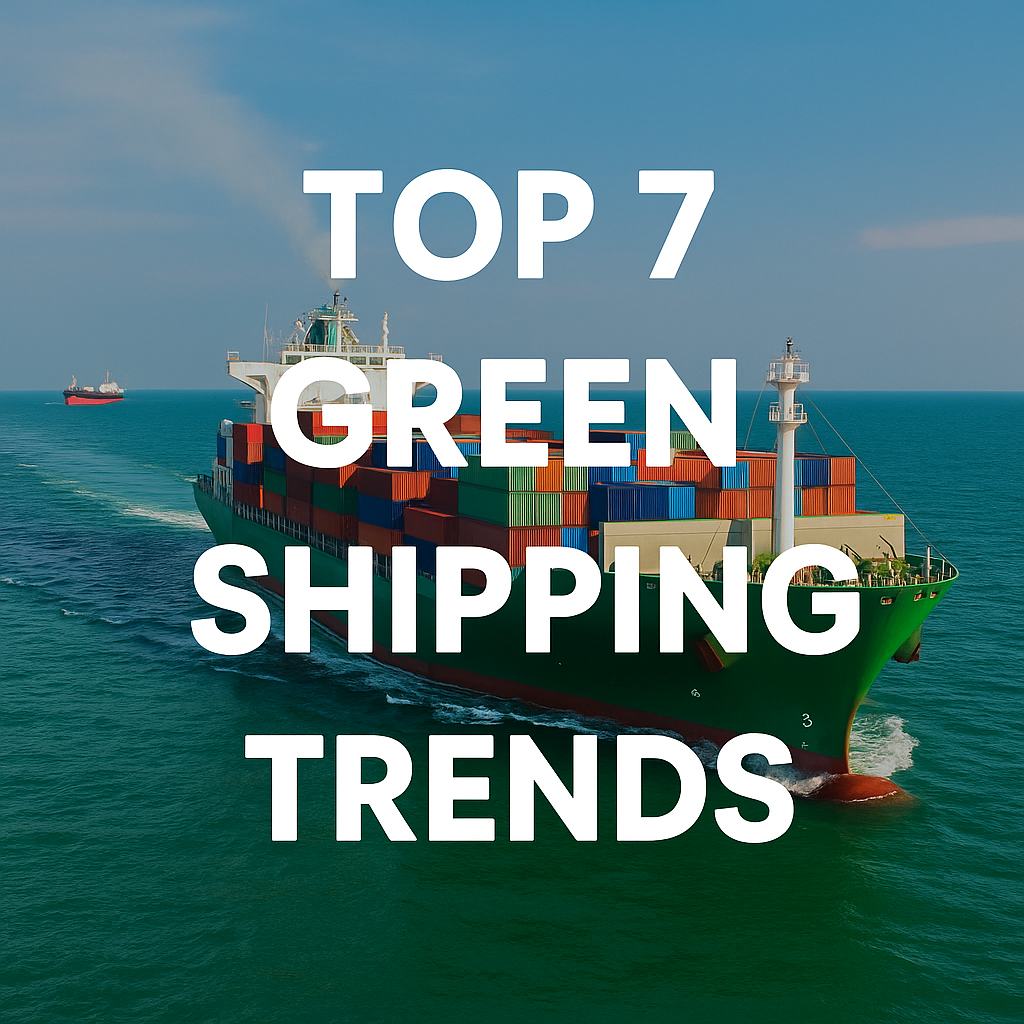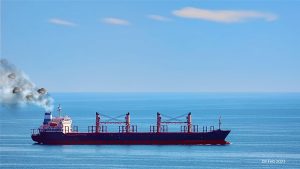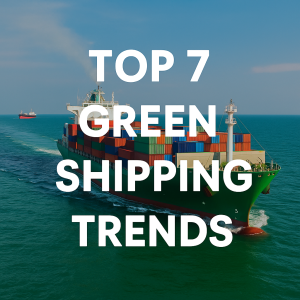Explore seven innovative green shipping trends—from alternative fuels to digital twins—that are essential to achieving IMO’s 2050 net‑zero goals. Discover how the maritime industry is transforming now and into the future.
Why Green Shipping Trends Matter Now
International shipping currently contributes around 3% of global greenhouse gas emissions, a figure projected to rise to 5–8% by 2050 if unchecked .As the backbone of world trade, the industry must evolve—fast. The IMO’s 2023 GHG Strategy updated reduction targets, and last April, IMO members agreed to a global carbon-pricing mechanism.Following this, a wave of green shipping trends is reshaping vessels, ports, and operations to reach that net-zero 2050 vision.
1 – Transitioning to Zero‑Carbon Fuels: Methanol, Ammonia & Green Hydrogen
Zero-carbon fuels like green methanol, ammonia, and hydrogen are central to the maritime industry’s path to decarbonization. These fuels emit little or no greenhouse gases when produced using renewable electricity and used onboard vessels.
Real-World Examples:
-
Maersk has taken a pioneering role by ordering 25 dual-fuel methanol-powered container ships from Hyundai Mipo and Hyundai Heavy Industries, many already under construction and some delivered in 2024.
-
COSCO Shipping and X-Press Feeders are following suit, with methanol-ready ships ordered to operate on intra-Asia routes.
-
In 2023, the world’s first ammonia-powered tugboat—developed by Amogy in partnership with the U.S. Department of Energy—completed successful harbor trials in New York.
-
Proman Stena Bulk, a joint venture between Proman and Stena, has launched several methanol-fueled tankers operating globally, proving methanol’s feasibility in deep-sea shipping.
Although e-fuels cost 2–3 times more than conventional marine fuel oil (MFO), this gap is expected to close due to rising carbon pricing mechanisms, subsidies, and FuelEU Maritime policies. Additionally, green fuel bunkering infrastructure is expanding in major hubs like Singapore, Rotterdam, and Shanghai.
2 – Retrofitting Existing Vessels for Cleaner Operations
Retrofitting the current fleet is essential, given that over 50,000 commercial vessels operate globally and cannot all be replaced immediately.
Examples and Developments:
-
MOL (Mitsui O.S.K. Lines) is retrofitting its bulk carriers with dual-fuel LNG engines and wind propulsion systems (e.g., Wind Challenger).
-
Eastern Pacific Shipping has launched a retrofit program for methanol dual-fuel conversion.
-
Carbon capture at sea is gaining traction—Panama-flagged tanker “CO2 Pioneer” recently trialed onboard capture tech developed by Samsung Heavy Industries.
Classification societies like DNV, ABS, and Lloyd’s Register now offer retrofitting guidelines, cost-assessment tools, and “fuel readiness” notations to support owners during energy transitions.
3 – Digitalization: Digital Twins & AI‑Driven Optimization
Digital tools are enhancing energy efficiency by allowing ships to simulate performance and adjust operations in real time.
Practical Applications:
-
The ZESTA (Zero Emission Services Twin Architecture) project uses digital twins to model vessel energy consumption under various operational conditions. It’s being trialed on electric barges in the Netherlands.
-
Kongsberg’s Vessel Insight platform is used across fleets to optimize routing and engine load using AI, resulting in 5–10% fuel savings.
-
NYK Line uses onboard AI to monitor weather, engine loads, and fuel types, reducing carbon intensity and enabling dynamic eco-routing.
4 – Wind‑Assisted Propulsion Making a Comeback
Modern shipping is reviving wind power through mechanical and automated systems that supplement traditional engines.
Examples:
-
Wallenius Marine’s “Oceanbird”—a concept car carrier using rigid wing sails—is projected to cut emissions by 90% compared to conventional vessels. A prototype vessel is under construction.
-
K Line has installed Airseas Seawing kite systems on bulkers. Trials show up to 20% fuel savings in favorable conditions.
-
Norsepower’s rotor sails have been deployed on Maersk and Scandlines vessels, offering consistent 5–10% efficiency gains with minimal retrofitting complexity.
These systems are particularly effective for slow-steaming bulk carriers and RoRo vessels on long oceanic crossings.
5 – Shore Power and Port Electrification (Cold Ironing)
Shore power systems allow ships to plug into land-based electricity while docked, cutting emissions in port—where air quality concerns are often acute.
Deployment Highlights:
-
Port of Los Angeles and Long Beach mandate shore power for all container and cruise vessels. Emissions at berth have been cut by over 90% for compliant ships.
-
Port of Rotterdam and Port of Busan are investing heavily in high-capacity cold ironing to support green shipping corridors.
-
MSC Cruises’ newer ships, like MSC World Europa, are shore-power ready and actively plug into port grids in Valencia, Hamburg, and Genoa.
6 – Carbon Pricing and Market-Based Measures
Economic levers are reshaping fuel choices. The IMO’s revised GHG Strategy includes carbon pricing schemes starting 2027–28.
Key Developments:
-
The EU Emissions Trading System (ETS) now includes maritime shipping (effective January 2024), covering CO₂ emissions from voyages within the European Economic Area.
-
The IMO is drafting a universal carbon pricing mechanism (expected 2025 adoption), with per-ton charges on CO₂ emissions.
-
Anticipated global “Green Fuel Standard” will require a minimum share of low-carbon fuels in maritime energy mixes, guiding investment in bunkering infrastructure and engine design.
7 – R&D, Technology Partnerships & Global Capacity Building
To ensure a just and global transition, capacity building for developing nations and SIDS (Small Island Developing States) is essential.
Examples:
-
The IMO Climate Finance Strategy channels $40–60 billion annually from carbon revenues into developing port infrastructure, green fuel access, and training.
-
The Green Corridor between Busan and Tacoma is a high-profile pilot connecting Korea and the U.S., with support from Samsung Heavy, Hyundai Merchant Marine, and U.S. ports.
-
Japan’s ClassNK is leading a Pacific Island capacity-building initiative to train crews in handling ammonia and methanol safely.
8 – Energy Efficiency Technologies for Immediate Impact
Fuel savings can be achieved today with existing tech—often at relatively low cost and risk.
Widespread Applications:
-
Advanced hull coatings, like Jotun’s Hull Skating Solutions, reduce biofouling drag and deliver up to 10% fuel savings.
-
Waste heat recovery systems are installed on Maersk Triple-E vessels to convert exhaust gas into usable energy, boosting overall efficiency by 8–10%.
-
Air lubrication systems (e.g., Silverstream Technologies) create a layer of bubbles beneath hulls. Carnival Cruises and Eastern Pacific Shipping are already using them with promising results.
-
Energy-saving devices, such as Becker Mewis Ducts and propeller boss cap fins, are now standard on many newbuilds, with savings of 5–6% verified by independent trials.
Case Study: Maersk’s Methanol Fleet Initiative
Maersk has ordered 19 methanol-powered vessels, secured green methanol supply, and integrated the new IMO fuel standards into investment strategies. They’re adopting a “green bonus” to reward early compliance—mirroring IMO’s broader levies and feebates.
FAQ
Q1: Are methanol and ammonia truly zero-carbon?
Only if made from renewable energy (green methanol/hydrogen‑based ammonia). Otherwise, lifecycle emissions remain high.
Q2: What is IMO’s Net-Zero Framework?
A binding carbon-pricing scheme under MARPOL Annex VI, beginning ~2028 for vessels >5,000 GT.
Q3: Can old ships retrofit to green fuels?
Yes—many retrofit kits for methanol/LNG exist. However, engine space, safety systems, and cost depend on vessel characteristics and class approval .
Q4: How effective are wind propulsion aids?
They can cut fuel use by 5–20%. Widespread use depends on trade route suitability, retrofitting cost, and regulatory acceptance .
Q5: How are developing nations included?
Revenues from pricing schemes will fund capacity-building, infrastructure, and tech-sharing under IMO’s strategy.
Conclusion: Sailing Towards a Blue, Green Future
These seven green shipping trends—alternative fuels, retrofitting, digital twins, wind propulsion, shore power, carbon pricing, and efficiency tech—are shaping a just, resilient decarbonization journey. As IMO enforces mid-term regulations and the Net-Zero Framework enters force in 2027–28, the industry stands at a crossroads: retrofit or rebuild, innovate or fall behind. But with vessel orders, port corridors, and funding structures emerging, momentum is undeniable.
For professionals, students, and seafarers, engaging with these trends is not optional—it defines the future of maritime transport and global climate action.
References
-
IMO. (2025). IMO approves net‑zero regulations for global shipping en.wikipedia.org+5imo.org+5en.wikipedia.org+5
-
Reuters. (2025). Shipping industry still at sea as it tries to navigate to net zero unglobalcompact.org+3reuters.com+3en.wikipedia.org+3
-
Wikipedia. (2025). Methanol fuel; IMO Net‑Zero Framework; Decarbonization of shipping en.wikipedia.org+1en.wikipedia.org+1
-
Bloomberg. (2023). Methanol Takes Lead in Shipping’s Quest for Green Fuel en.wikipedia.org
-
AP News. (2024). Tugboat powered by ammonia sails for the first time apnews.com
-
Sciencedirect. (2024). A wind-to-wake approach for selecting future marine fuels sciencedirect.com
-
Academia ArXiv. (2024). Data‑driven models improve vessel energy efficiency arxiv.org
-
ArXiv. (2024). Digital twins in zero‑emission short‑sea vessels
-
Global Maritime Forum. (2025). Green shipping corridors initiative washingtonpost.com+4wwwcdn.imo.org+4apnews.com+4



